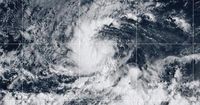Tropical Storm Kiko, the eleventh named storm of the 2025 Eastern Pacific hurricane season, has formed far out in the eastern Pacific Ocean, according to multiple meteorological sources including the U.S. National Hurricane Center (NHC) in Miami. As of Sunday, August 31, 2025, Kiko was churning more than 1,000 miles from the nearest landmass, situated roughly 1,045 to 1,120 miles west-southwest of the southern tip of Baja California. This remote location means there is currently no immediate threat to land, but the storm’s development is being closely monitored by meteorologists and weather agencies across the Pacific region.
The NHC reported that Kiko’s maximum sustained winds reached 40 to 45 mph (65 to 72 km/h) on Sunday evening, with higher gusts possible. The storm was moving westward at a steady pace of about 9 mph (15 km/h). The defining characteristics of a tropical storm—sustained winds between 39 mph (63 km/h) and 73 mph (117 km/h)—placed Kiko squarely within this range, but forecasts indicated that further strengthening was imminent. "Strengthening is expected during the next couple of days, and the system is forecast to become a hurricane by Tuesday," the hurricane center stated, as reported by News Arena Network and other outlets.
Satellite imagery and advanced radar technology have been instrumental in tracking Kiko’s progress. According to a National Hurricane Center discussion cited by BIVN, satellite data showed a curved band of clouds wrapping around the western semicircle of the cyclone, with a burst of deep convection developing over the center. Cloud tops were observed near -80°C, a hallmark of robust storm development. The convective banding, which now wraps more than halfway around the storm’s core, supported the decision to officially name the system Tropical Storm Kiko, with an initial intensity estimate of 35 knots (about 40 mph).
Environmental conditions have been described as favorable for continued strengthening. The NHC and Hawaii News Now both noted that Kiko is currently traversing an area with warm sea surface temperatures, moist tropical air, and little vertical wind shear. These factors, combined with a strong subtropical ridge to the north, are expected to keep Kiko on a generally westward path for at least the next five days. The storm’s trajectory could eventually take it into the Central Pacific basin by late in the week, with some forecast models suggesting it could come close to the Hawaiian Islands. However, as of Sunday, the exact track remained uncertain and subject to change, with meteorologists urging caution and continued monitoring.
By Tuesday, September 2, 2025, Kiko is forecast to reach hurricane strength, with some models predicting it could escalate to a Category 2 hurricane by Wednesday. The NHC’s official track and intensity forecasts are based on consensus models and remain close to previous projections. Should Kiko’s path deviate slightly to the right, the storm could encounter cooler waters, which would likely inhibit further intensification. Conversely, if it maintains its westward course over warm waters and moist air, it could continue to strengthen steadily.
As reported by Hawaii News Now, tropical storm force winds extended outward up to 45 miles from Kiko’s center as of Sunday evening. These winds, while not currently threatening any landmass, are a reminder of the storm’s potential should its path shift. The NHC has not issued any coastal watches or warnings as of August 31, and there is no immediate cause for alarm among coastal residents in Mexico, Hawaii, or elsewhere. Still, the situation could evolve, and meteorologists are keeping a close eye on the system’s progress.
The 2025 Eastern Pacific hurricane season began on May 15 and runs through November 30, typically peaking in late summer. Kiko is the eleventh named storm of the season, highlighting a period of heightened activity in the region. Historically, most Pacific storms like Kiko move west, away from mainland North America. Occasionally, however, shifting atmospheric conditions can steer storms north or northeast toward the Baja California peninsula and even the west coast of Mexico. Notably, Hurricane Hilary in 2023 took such a path, bringing damaging winds and intense rainfall to Southern California—a rare event that serves as a cautionary tale for forecasters and residents alike.
Modern meteorological tools offer a comprehensive view of storms like Kiko. Satellite imagery helps determine the strength, size, and structure of the system, while radar data tracks rainfall, wind speeds, and the potential for hazards such as power outages and flooding. The National Hurricane Center, in conjunction with the National Oceanic and Atmospheric Administration (NOAA) and other agencies, provides regular updates, forecasts, and tracking maps to keep the public informed. These resources are critical for emergency planners and residents in the broader Pacific region, even when a storm is far from land.
Despite Kiko’s current distance from populated areas, the storm is a reminder of nature’s power and unpredictability. Forecast models, while sophisticated, cannot always account for sudden shifts in atmospheric conditions. As Hawaii News Now cautioned, "Current forecast models are bringing Kiko close to the islands, but it’s too soon to tell exactly where it will go and the forecast track can and will change." If Kiko were to move just slightly off its predicted path, it could come closer to Hawaii, but it would also likely encounter cooler waters, which would slow its growth.
For now, Kiko’s story is one of watchful waiting. Meteorologists and weather enthusiasts alike are keeping tabs on the storm’s every move, using the latest technology and expertise to predict its future. The public is encouraged to stay informed, especially as the hurricane season continues and new storms inevitably develop. The lessons of past seasons—such as the unexpected impact of Hurricane Hilary—underscore the importance of vigilance, even when a storm seems distant and harmless.
As the week unfolds, all eyes remain on the Pacific, where Kiko’s fate will be determined by the interplay of warm waters, atmospheric pressure systems, and the ever-changing dynamics of the ocean and sky. Whether Kiko strengthens into a major hurricane or fizzles out over cooler waters, the storm serves as a timely reminder of the need for preparedness and respect for the forces of nature.



